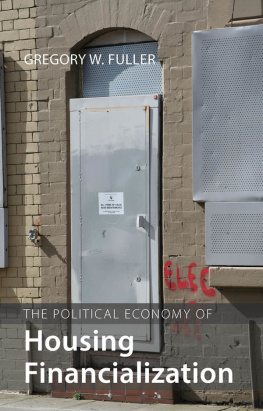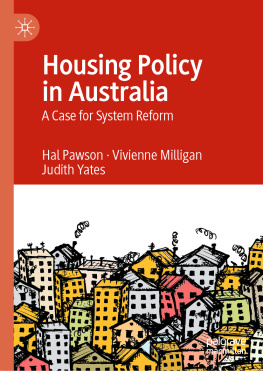Principles of Housing Finance Reform
THE CITY IN THE TWENTY-FIRST CENTURY
Eugenie L. Birch and Susan M. Wachter, Series Editors
A complete list of books in the series
is available from the publisher.
PRINCIPLES
OF HOUSING
FINANCE
REFORM

Edited by
Susan M. Wachter
and
Joseph Tracy

Copyright 2016 University of Pennsylvania Press
All rights reserved. Except for brief quotations used
for purposes of review or scholarly citation, none of this
book may be reproduced in any form by any means without
written permission from the publisher.
Published by
University of Pennsylvania Press
Philadelphia, Pennsylvania 191044112
www.upenn.edu/pennpress
Printed in the United States of America
on acid-free paper
10 9 8 7 6 5 4 3 2 1
A Cataloging-in-Publication record is available from
the Library of Congress
ISBN 978-0-8122-4862-3
CONTENTS

Susan M. Wachter and Joseph Tracy
David Scharfstein and Phillip Swagel
Patricia C. Mosser, Joseph Tracy, and Joshua Wright
Diana Hancock and Wayne Passmore
Mark A. Willis and John Griffith
Kevin A. Park and Roberto G. Quercia
W. Scott Frame
Akash Kanojia and Meghan Grant
Stephanie Heller and Dale A. Whitman
Susan M. Wachter
Susan M. Wachter and Joseph Tracy
In the fall of 2008, the world watched in horror as the U.S. housing finance system shattered, triggering a global financial panic and ultimately the Great Recession. Now, nearly a decade later, the long and slow recovery has reached a critical moment. Though the housing finance system has stabilized, it remains in the hands of the federal government, leaving taxpayers, rather than private capital, largely exposed to the credit risk. Fannie Mae and Freddie Macthe government-sponsored enterprises (GSEs) responsible for most of the countrys residential mortgage securitizationcontinue to be held in conservatorship by the Federal Housing Finance Agency (FHFA). Meanwhile, private funding remains mostly on the sidelines, with the source of ongoing financing necessary for sustainable, affordable homeownership still unknown. An eager young generation is unable to access the credit or afford the down payments necessary to successfully transition from renting to owning. This lingering inertia is a critical weakness in the American economy. The system must be rebuilt.
This volume identifies changes necessary to modernize the housing finance system. The chapters lay out a road map for reforms to achieve the goals of access, liquidity, stability, and sustainability. They represent some of the best thinking of policy researchers and economic experts to the challenges that lie ahead for the rebuilding of this key sector of our nations economy.
Housing finance reformers have not been short of options. In the wake of the Great Recession, proposals have arisen across the political spectrum, spanning the range from immediate privatization to complete government takeover. The chapters in this book center around four points of consensus that have formed among the major stakeholders.
First, the thirty-year fixed-rate mortgage should remain available as a source of funding for households, correctly priced for risk. This mortgage allows households to own and hedge rent increase risk while also hedging interest rate risk. The mortgage product shifts that risk to capital markets, which are better equipped to manage rate risk than households. This mortgage is also simple to understand and to evaluate in terms of the households ability to pay.
To ensure this, the to-be-announced (TBA) market, as presented in the chapter by Akash Kanojia and Meghan Grant, is necessary to ensure a liquid secondary outlet, without which originators would be far less willing to issue this type of loan. This liquid secondary outlet helps to keep this mortgage affordable.
Second, borrowers followed by private capital must take the first losses when mortgages default. Market discipline is necessary to prevent borrowers, originators, and MBS investors from taking excessive risks. Equally important, however, is government support for catastrophic losses that the private market cannot sustain without total collapse. In contrast to the past, this support should be made explicit and priced going forward.
Third, securitization must operate in daylight with some form of standardizationon a common, transparent platform where investors and regulators can obtain information for pricing. All participants must understand the risks involved in securitization, unlike the information asymmetries that allowed underpriced credit to fuel the latest housing bubble.
Fourth, the government should not abandon its policy of encouraging affordable housing by simply leaving the free market to its own devices. Across the country, rapidly rising rents and tightened underwriting standards have combined to make the cost of housing a significant strain on the budgets of an American middle class that is already suffering from decades of income stagnation and is still struggling to deleverage. However, government efforts to support affordable mortgages must also ensure that they are sustainable as well.
These principles must be implemented through a newly structured system that is sustainable with fundamental restructuring for stability. To this end, the authors in this book present proposals for long-term structural reforms. Though they are varied in their aims and their strategies, they demonstrate the bounty of innovation that is possible within these guiding principles. Each chapter suggests reforms that would infuse new life into our housing finance system as well as provide long-term stability.
, Diana Hancock and Wayne Passmore propose the mandatory usage of private-sector mortgage insurance to encourage investment without putting taxpayers at undue risk.
The second three chapters acknowledge that these reforms require attention to affordability, highlighting the role of the Federal Housing Administration (FHA), Federal Home Loan Bank (FHLB) system, and affordable multifamily housing. In , W. Scott Frame tells the story of the FHLB system (the other housing GSE), how they weathered the financial crisis and how they too can better balance public lending with measured risk taking.
Finally, the last three chapters describe the basic requisites for reforma twenty-first-century infrastructure to ensure widespread dissemination of real-time information and access to liquidity for all market participants. In identifies the information requisites for more stable securitization.
Together, these chapters provide us with the full scope of reform efforts that are likely to enter into discussion. In truth, we are unlikely to see another moment so full of opportunities to improve the housing finance system. We have waited long enough to begin the great task of rebuilding the foundation that cracked beneath our feet in 2007. The conservatorship of the GSEs has lasted too long and needs to be replaced with a new vision. Housing finance is the final piece of a puzzle that deserves to be finished. The path of its reform will determine the future of the American dream. We believe that the research in this volume can inform the important policy choices that will help determine that future.
Next page









